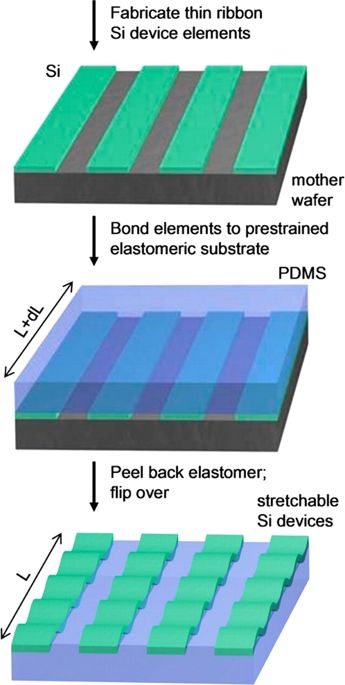npj Flexible Electronics ( IF 12.3 ) Pub Date : 2017-10-05 , DOI: 10.1038/s41528-017-0004-y Bo Wang , Siyuan Bao , Sandra Vinnikova , Pravarsha Ghanta , Shuodao Wang

|
In the last decade, stretchable electronics evolved as a class of novel systems that have electronic performances equal to established semiconductor technologies, but can be stretched, compressed, and twisted like a rubber band. The compliance and stretchability of these electronics allow them to conform and mount to soft, elastic biological organs and tissues, thereby providing attractive opportunities in health care and bio-sensing. Majority of stretchable electronic systems use an elastomeric substrate to carry an ultrathin circuit mesh that consists of sparsely distributed stiff, thin-film electronic components interconnected by various forms of stretchable metal strips or low-dimension materials. During the fabrication processes and application of stretchable electronics, the thin-film components or nanomaterials undergo different kinds of in-plane deformation that often leads to out-of-plane or lateral buckling, in-surface buckling, or a combination of all. A lot of creative concepts and ideas have been developed to control and harness buckling behaviors, commonly regarded as pervasive occurrences in structural designs, to facilitate fabrication of stretchable structures, or to enhance stretchability. This paper provides a brief review of recent progresses on buckling analysis in stretchable electronics. Detailed buckling mechanics reveals important correlations between the geometric/material properties and system performance (e.g., mechanical robustness, deformability, structural architecture, and control). These mechanics models and analysis provide insights to design and optimize stretchable electronics for a wide range of important applications.
中文翻译:

可伸缩电子学中的屈曲分析
在过去的十年中,可伸缩电子技术发展成为一类新颖的系统,其电子性能与已确立的半导体技术相同,但可以像橡皮筋一样被拉伸,压缩和扭曲。这些电子设备的顺应性和可拉伸性使其可以顺应并安装在柔软,有弹性的生物器官和组织上,从而在医疗保健和生物传感领域提供了诱人的机会。大多数可拉伸电子系统都使用弹性体基板来承载超薄电路网,该电路网由稀疏分布的刚性薄膜电子组件组成,这些电子组件通过各种形式的可拉伸金属条或低维材料相互连接。在可拉伸电子产品的制造过程和应用过程中,薄膜组件或纳米材料会经历不同类型的面内变形,这些变形通常会导致面外或横向屈曲,表面内屈曲或所有这些的组合。已经开发出许多创造性的概念和想法来控制和控制屈曲行为,这些行为通常被认为是结构设计中普遍存在的现象,以促进可拉伸结构的制造或增强可拉伸性。本文简要回顾了可伸缩电子产品中屈曲分析的最新进展。详细的屈曲力学揭示了几何/材料特性与系统性能(例如,机械强度,可变形性,结构结构和控制)之间的重要关联。











































 京公网安备 11010802027423号
京公网安备 11010802027423号